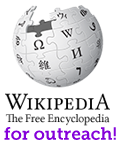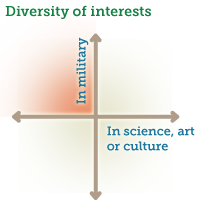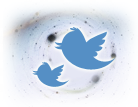Community Embraces New Word Game at Mid-Year Play Day This past Sunday, families at Takoma Park’s Seventh Annual Mid-Year Play Day had the opportunity to experience OtherWordly for the first time. Our educational language game drew curious children and parents to our table throughout the afternoon. Words in Space Several children gathered around our iPads […]
Read moreCategory: Communication
 Wikipedia, the free, online encyclopedia that “anyone can edit,” is a useful way to deliver scientific and cultural knowledge to the public. Wikipedia is the 5th most visited web site, with 400–450 million unique visitors per month.
Wikipedia, the free, online encyclopedia that “anyone can edit,” is a useful way to deliver scientific and cultural knowledge to the public. Wikipedia is the 5th most visited web site, with 400–450 million unique visitors per month.
It’s not “merely a larger audience, but a different audience,” says Sara Snyder, webmaster for the Smithsonian Institution’s Archives of American Art, who has recently started to use Wikipedia more. She says, “Our main website is geared towards an academic-minded or university-level student, researcher, curator, or professional art historian. Yet we have information and collections that may inform or appeal to a broader set of folks, such as younger students and art enthusiasts. Wikipedia is a platform for trying to start serving those researchers too, without overhauling the current way we do business or our existing website.” (more…)
There’s a great new video on YouTube, “I’m a climate scientist.” It uses gangsta-rap flavor to bring home the point that a lot of people talking about climate change are not actual climate scientists. Here’s the video, which contains some expletives:
If you are at work, or don’t like the word “F##k,” try out this clean version. Here’s the story… (more…)
![]() Fast talks enliven conferences. Ignite and TEDx are two models of fast-paced, engaging and fun conferences which can be adapted for both public-oriented conferences and professional conferences. It’s a refreshing break from long lectures and panel discussions… (more…)
Fast talks enliven conferences. Ignite and TEDx are two models of fast-paced, engaging and fun conferences which can be adapted for both public-oriented conferences and professional conferences. It’s a refreshing break from long lectures and panel discussions… (more…)
 Open access journals are transforming how researchers share information, and how the public can access it. They are peer reviewed journals which are digital, online, free of charge, and free of most copyright and licensing restrictions.
Open access journals are transforming how researchers share information, and how the public can access it. They are peer reviewed journals which are digital, online, free of charge, and free of most copyright and licensing restrictions.
Open access journals are now commonplace. As of last lear, nearly 10% of scholarly articles were published in open access journals. There are now currently over 7500 open access journals, according to the Directory of Open Access Journals (DOAJ), which indexes freely available, peer-reviewed journals that don’t have an embargo period (see criteria). (more…)
 Social media can feel like you are talking to the world, but in reality there’s a lot of self-selection going on. So know your audience.
Social media can feel like you are talking to the world, but in reality there’s a lot of self-selection going on. So know your audience.
Before the Internet, the gatekeepers of public information (journalists, editors and producers) considered the needs of audiences for you. These gatekeepers would filter a fire-hose of information in press releases and technical publications to deliver a digested slivers of information via television news, tv, print, and trade press. Other kinds of technical information was discussed at conferences, at meetings, in journals or in private. (See my post about “Fall of the gatekeepers“) (more…)
 National security is a useful angle for presenting science, art and culture issues to disengaged or skeptical audiences.
National security is a useful angle for presenting science, art and culture issues to disengaged or skeptical audiences.
 Like any hook, such as sports or popular culture, military and national security themes broaden an audience for outreach. There are over 3.6M military personnel in the U.S., 1.9M spouses & kids of active duty members, and over 22M veterans, who also have families. (Stats on personnel & families, and veterans.)
Like any hook, such as sports or popular culture, military and national security themes broaden an audience for outreach. There are over 3.6M military personnel in the U.S., 1.9M spouses & kids of active duty members, and over 22M veterans, who also have families. (Stats on personnel & families, and veterans.)
There are several initiatives which are bridging the military world with the sciences and culture…
(more…)
 On Twitter, almost no one hears you. Or at least that’s the case for 99.95% of Twitter users whose Tweets evaporate into the aether, scrolling off the feed, leaving scarcely a trace.
On Twitter, almost no one hears you. Or at least that’s the case for 99.95% of Twitter users whose Tweets evaporate into the aether, scrolling off the feed, leaving scarcely a trace.
According to statistics released last week by Twitter, users now send a billion Tweets a week (up nearly 3x from 350M a year ago). But most of those Tweets get little attention, reports a new study, to be presented next week at a web conference in India. The study found that attention is highly concentrated among a very narrow slice of Twitter users. Read on for more about the findings…
(more…)

The term “strategic communications” has become popular over the last two decades. It means infusing communications efforts with an agenda and a master plan. Typically, that master plan involves promoting the brand of an organization, urging people to do specific actions, or advocating particular legislation.
It can refer to both a process, and to a specific job title.
 When web sites invite commenting, they open the door to unwanted comments. By quickly identifying types of unwanted comments, you know which comments to delete quickly, which to consider responding to, versus which are part of a healthy community.
When web sites invite commenting, they open the door to unwanted comments. By quickly identifying types of unwanted comments, you know which comments to delete quickly, which to consider responding to, versus which are part of a healthy community.
The following are common species of unwanted comments…


 Drones, spy robots, Mach 6 warplanes, new energy sources, and climate monitoring are just a few of the new technologies being developed by the U.S. military to fight the wars of the future. These technologies depend on cutting edge scientific knowledge, and are fantastic ways to get the military-oriented public (nearly
Drones, spy robots, Mach 6 warplanes, new energy sources, and climate monitoring are just a few of the new technologies being developed by the U.S. military to fight the wars of the future. These technologies depend on cutting edge scientific knowledge, and are fantastic ways to get the military-oriented public (nearly